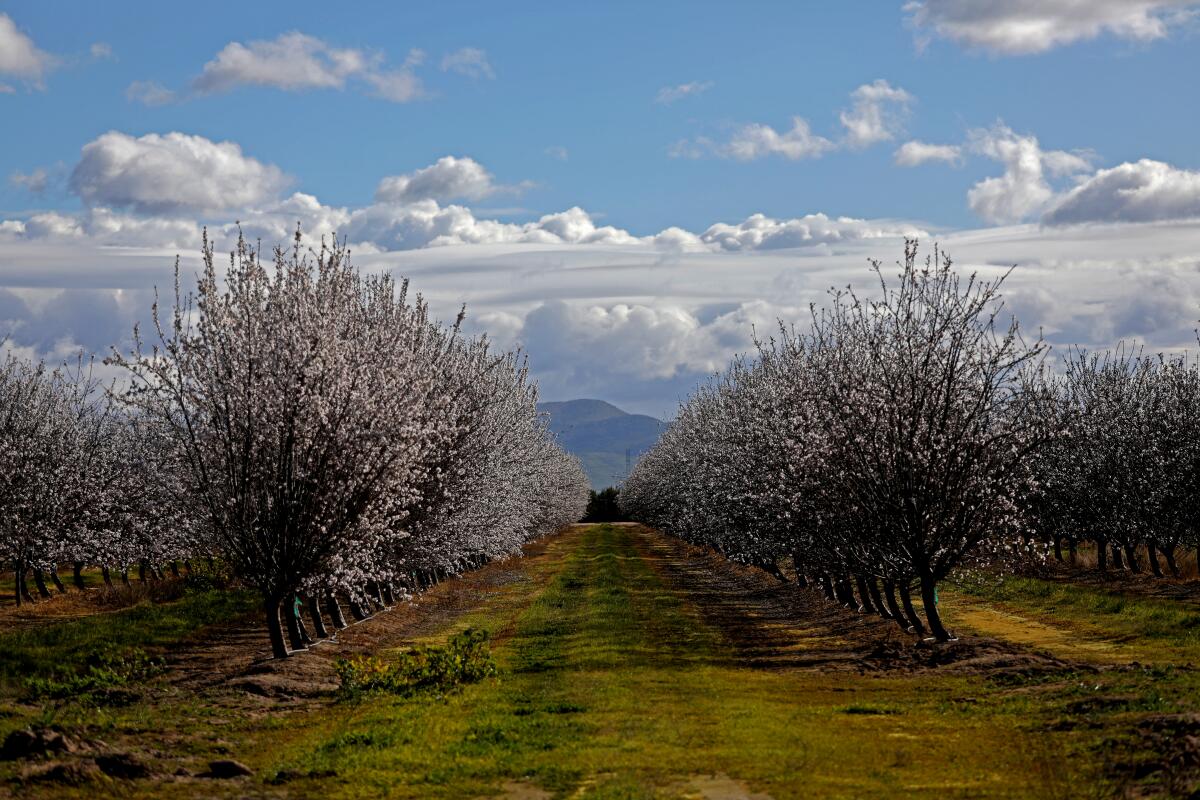California may have reached ‘peak almond.’ What happens next?

- Share via
Good morning. It’s Tuesday, March 5. Here’s what you need to know to start your day.
- What’s next for California’s overgrown almond industry?
- Voting last minute in the California primary election? Here’s your guide
- The best places to eat and drink in L.A. this month
- And here’s today’s e-newspaper
Sign up for Essential California
The most important California stories and recommendations in your inbox every morning.
You may occasionally receive promotional content from the Los Angeles Times.
Has California reached ‘peak almond’?
California grows about 80% of the world’s almonds, with thousands of orchards spanning the state — many of them in the Central Valley. The state exports the majority of the crop and the tree nuts have become a staple of many pantries and fridges — and not just in trail mix. Think almond milk, almond butter and almond flour.
But after roughly a decade-long boom, the market is in a slump, The Times’ Ian James reported this week.
“Prices have dropped over the last several years, and the state’s total almond acreage has started to decrease as growers have begun to tear out orchards and plant other crops,” Ian wrote. “In a sign of the troubles besetting the industry, one large almond-growing conglomerate has declared bankruptcy.”
That corporation, Trinitas Farming, cited record-low prices and high interest rates on land purchases. The total acreage devoted to almond growing has shrunk in the last two years as some farmers opt to plant other crops, while some orchards have been abandoned.
One factor in the price drop: too many almonds, not enough demand.
“It’s possible that we have hit peak almond,” Caity Peterson, associate director of the Public Policy Institute of California’s Water Policy Center, told Ian. “The industry will probably right-size itself to where the supply better meets the demand and it’s not oversupply, like we’ve got right now.”
So what could the future of almond growing look like in California?
Although some industry experts Ian spoke with expect a rebound, some critics see the thirsty crop’s downturn as an opportunity to rethink agricultural priorities as California works to build water resiliency.
As the almond industry blossomed, more growers were using more groundwater to cultivate the water-intensive crop, tapping an already depleted supply during drought years. New state rules in the pipeline aim to limit agricultural water use to help recharge aquifers after years of overpumping and drought.
“Researchers with the Public Policy Institute of California have estimated that addressing the groundwater deficit in the San Joaquin Valley will probably require taking at least half a million acres of farmland out of production,” Ian noted. “They’ve called for expanding efforts to help convert farmland to other uses, such as solar development or habitat areas.”
You can read more about the state of the state’s almond industry in Ian’s story.
Today’s top stories
Elections and politics
- Voting last minute in the California primary election? Here’s your guide.
- L.A. Metro to offer free bus and train rides on primary election day.
- Forget election night answers: Results may take far longer in many close races.
- A rookie at age 75? Former Dodgers are surprised Steve Garvey took so long to enter politics.
- Your guide to the L.A. County district attorney race: 11 candidates aim to unseat Gascón.
- Voter guide to the 2024 California primary election.
- The Supreme Court rules Trump will stay on Colorado ballot despite Jan. 6 attack.
More big stories
- Two people were seriously injured after a Tesla flies off the freeway overpass in Los Feliz, and bursts into flames.
- Ojai becomes the second U.S. city to ban ‘horrible, indiscriminate killing devices’: glue traps.
- How beloved bakery Sweet Lady Jane found a new owner. It reopens this month.
- 30 tons of Trader Joe’s Chicken Soup Dumplings recalled for possible contamination.
- A ‘gun battle’ involving U.S. border agents kills one in San Diego County near the Mexico border.
- Actor John Amos again shuts down neglect allegations, this time amid an LAPD investigation.
- After losing a world champion boxer’s pension records, California finally admits error.
- A new IRS Direct File program is now available in California.
- Hurry! More than 100 rescued bunnies in Los Angeles need homes before they multiply.
Get unlimited access to the Los Angeles Times. Subscribe here.
Commentary and opinions
- Erika D. Smith: Most Californians haven’t voted yet and likely won’t. This is why I’m one of them.
- Harry Litman: For the second time in days, the Supreme Court helped make another Trump presidency possible.
- LZ Granderson: Biden and Trump? What a waste of the Super Tuesday primaries.
- Michael Hiltzik: Trump and RFK Jr. want to make the world safe again for polio and measles. You should be terrified.
- Mary McNamara: In Lady Jessica, ‘Dune’ created an all-time movie mom. Then ‘Part Two’ ruined her.
- Doyle McManus: Biden should hope he gets heckled at his State of the Union speech.
- Robin Abcarian: Bravo to France for guaranteeing the right to abortion in its Constitution — a worldwide first.
Today’s great reads

Threatened in their homeland, feral Mexican parrots thrive on L.A.’s exotic landscaping. Why do feral Mexican parrots thrive in L.A. but struggle to survive in their native land? A potential answer is that Southern California cities have only in the last 100 years provided these sister species with a resource untapped by native birds: the fruits and flowers of exotic trees used for landscaping.
Other great reads
- A Jewish family, a famous European museum and the battle for a Nazi-looted masterpiece.
- Hugo Miller overcomes stereotypes to fulfill his dancing dream — and inspire others.
How can we make this newsletter more useful? Send comments to essentialcalifornia@latimes.com.
For your downtime
Going out
- Stephen Sachs documents an American family torn apart by Jan. 6 in his new play — on stage at the Fountain Theatre.
- The best places to eat and drink in L.A. this month, according to our food writers.
- 11 invigorating solo date ideas to craft a lovely L.A. day.
Staying in
- 🧑🍳 Here’s a recipe for grilled salmon teriyaki.
- ✏️ Get our free daily crossword puzzle, sudoku, word search and arcade games.
And finally ... a great photo
Show us your favorite place in California! We’re running low on submissions. Send us photos that scream California and we may feature them in an edition of Essential California.

Today’s great photo is from Times photographer Mel Melcon inside the Highland Park home of Danny Bowman and Alex Grunbeck, two of L.A.’s art cool kids who are hosting exhibits in laundry rooms and garages.
Have a great day, from the Essential California team
Ryan Fonseca, reporter
Kevinisha Walker, multiplatform editor
Stephanie Chavez, deputy metro editor
Check our top stories, topics and the latest articles on latimes.com.
Sign up for Essential California
The most important California stories and recommendations in your inbox every morning.
You may occasionally receive promotional content from the Los Angeles Times.









